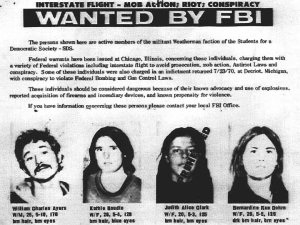The Weather Underground are primarily remembered for the violent militant tactics they used as a form of social activism. From bombings to prison breaks, to later arguably robbery in the case of Brinks, the question remains where did these tactics derive from? Where they the product on inspiration derived from a conflicting socio-economic climate brewing in America, and arguably the world at the time? Well to a degree yes, and to a degree no. During the 1970’s The Weather Underground took tactics from two of South and Central Americas most renown guerrilla revolutionaries, Those being Che Guevara, out of the Cuban Revolution, and Carlos Marighella, who was both involved with Guevara during the Cuban Revolution, and attempted to form his own communist revolution is his own country of Brazil. Taking tactics from these individuals and, putting their own ideology and form behind the ideals these two men presented the Weather Underground formed their own form of unique guerrilla tactics designed to succeed within a modern democracy.
To start what did the Weather Underground adapt from Guevara and the Cuban Revolution? Well to start it was in Cuba from prior revolutionaries that the Weather underground was first trained in the art of making explosive and propaganda, shortly after their conception at the Summer 1969 S.D.S convention. Furthermore the weather undergrounds entire organizational model was derived from the model primarily created by Guevara known as “Foco”. Foco itself was to a degree derived from Marxist tactics, including the Stalin tactic of a popular front, for the most part it also took in ideology from the Maoist strategy of “a peoples war”, in which large decisive battles would be strategically avoided, and the uprising would start within small groups, and then would begin to continuously grow larger. Foco changes, from traditional Maoist and Marxist tactics by focusing on an uprising entirely driven by workers and peasants without any outside or government help. Guevara believed it was a peoples war and an overthrow would occur because of the people.
Foco was employed by The Weather Underground as a basis for their organizational structure. Using small guerrilla cells throughout the nation, The Weather Underground was able to use tactics from hiding, and then disappear. Like the way Guevara planned these cells in Cuba, so did the Underground, having each cell use its own form of leadership, while communicating through a network of cells, and to the main cell located in New York. The Weather also actively advocated for the Foco idea of having the “revolution” be a people revolution, without the aid of outside government. Finally the ideology of avoiding decisive battles was taken into account. With the very limited personnel the Weather had at it’s disposal large scale decisive attacks would have to avoided. The way weather differs from Guevara and fallows more the ideology of Guerrilla tactics proposed by Carlos Marighella, was in location,ideology, and guerrilla action oriented tactics.
Within his writing, “Manuel of the Urban Guerrilla”, Carlos Marighella uses a very similar model to that of Guevara, except for a few key components. Components that would later be used by the Weather Underground. To start Marighella doesn’t believe that a successful revolution should begin in hidden suburban areas, such as woods and mountains. Marighella calls for action to be fought starting within large urban areas then spreading out towards the country-side. This is done in an effort to damage those in power where they hold the most power, and to show the greatest amount of the population how much damage a single individual can cause. This is also in an effort to in crease the speed of recruitment of new individuals to believe in the Guerrilla cause. Secondly Marighella, calls for direct hard hitting action attacks. Rather then attacking only to liberate new land, then retreating to rebuild such as the idea of Foco, Marighella calls for a continuously offensive Guerrilla movement, sometimes for no reason, but to keep the government guessing. This is in an effort to continuously pressure the enemy in order to draw them out, and have them make errors within their tactics. Finally Marighella, has a very unique ideology that differs from Guevara and greatly influences the Weather Underground. Where Guevara believes that a government is the oppressor, Marighella states that all oppressive governments have a large source of power backing them, of a more foreign government oppressor. In most of Marighella’s writings, and within the Weather Underground this oppressor is United States Imperialism.
The use of Marighella’s tactics are easy to see within The Weather Underground during the 1970’s. Almost all weather cells where located in large urban cities, The majority of the undergrounds tactics where offensive in nature, and maybe most importantly, both viewed the United States government as the primary imperialistic oppressor.
The Weather Underground did differ from these two models, however in two major ways. Firstly rather than a workers, (peoples) war, much of the weather underground believed far more in a war of the new age a youth war, fighting against archaic ideals of American Imperialism. Secondly, especially after the Greenwich Village explosion, The Weather Underground didn’t believe in or facilitate the death of “those compliant with the oppressor”, in this case officers of the law, government officials, and military personnel. In fact the Weather Underground went to very extensive lengths to avoid such deaths. This final non-fatality based ideology is the one major separator between the Weather Underground and other South and Central American revolutionary organizations.

